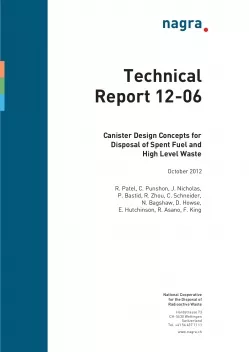
Technical Report NTB 12-06
Canister Design Concepts for Disposal of Spent Fuel and High Level Waste
As part of its long-term plans for development of a repository for spent fuel (SF) and high level waste (HLW), Nagra is exploring various options for the selection of materials and design concepts for disposal canisters. The selection of suitable canister options is driven by a series of requirements, one of the most important of which is providing a minimum 1'000 year lifetime without breach of containment. One candidate material is carbon steel, because of its relatively low corrosion rate under repository conditions and because of the advanced state of overall technical maturity related to construction and fabrication. Other materials and design options are being pursued in parallel studies. The objective of the present study was to develop conceptual designs for carbon steel SF and HLW canisters along with supporting justification. The design process and outcomes result in design concepts that deal with all key aspects of canister fabrication, welding and inspection, short-term performance (handling and emplacement) and long-term performance (corrosion and structural behaviour after disposal). A further objective of the study is to use the design process to identify the future work that is required to develop detailed designs.
The development of canister designs began with the elaboration of a number of design requirements that are derived from the need to satisfy the long-term safety requirements (minimum 1'000 year lifetime without breaching) and the operational safety requirements (robustness needed for safe handling during emplacement and potential retrieval). It has been assumed based on radiation shielding calculations that the radiation dose rate at the canister surfaces will be at a level that prohibits manual handling, and therefore a hot cell and remote handling will be needed for filling the canisters and for final welding operations. The most important canister requirements were structured hierarchically and set in the context of an overall design methodology. Conceptual designs for SF canisters, with a BWR fuel canister selected as a reference, and HLW canisters, based on two vitrified HLW containers per canister, were then developed. Corrosion, degradation, failure mechanisms, tolerance to fabrication flaws and other structural performance issues have been investigated in the context of proposed weld designs, inspection and manufacturing. Different ways of achieving compliance with the canister requirements have been explored.
The resulting design concepts provide a description of geometric shape, dimensions, material, welding and fabrication and inspection options for the canisters, including the internal supporting structures. The corrosion, material degradation, structural performance, weld design, inspection and manufacturing issues of each option are discussed, and it is shown how the proposed designs meet the canister requirements. One of the benefits of the study is that the design development and analysis of performance led to the identification of the specific work needed to develop detailed design concepts and prototype canisters. The most important aspects are developing the weld design, weld method and approach to post-weld stress relief, as well as the determination of the maximum allowable defect size and safety factor in relation to crack growth probability.
